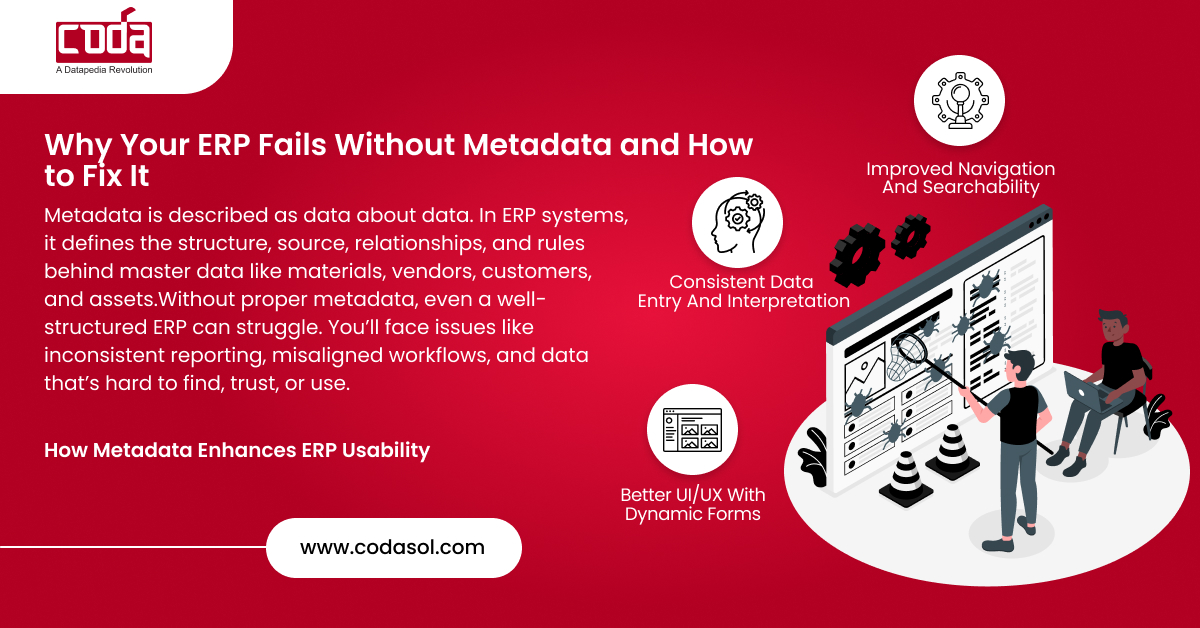Why Metadata is the Hidden Engine Behind ERP and MDM Success
Enterprise Resource Planning (ERP) systems are only as powerful as the data driving them. Yet many organizations overlook one silent powerhouse that governs usability, discoverability, and decision-making: metadata in ERP.
If your ERP feels clunky, your reports feel unreliable, or your Master Data Management (MDM) initiatives are stuck in neutral, metadata may be your missing link.
What is Metadata?
Metadata is often described as “data about data,” but in ERP systems, it goes deeper. It describes the structure, origin, relationships, usage, and governance rules around master data elements like materials, vendors, customers, and assets.
Common Types of Metadata in ERP:
- Technical Metadata: Data types, table names, field lengths
- Business Metadata: Definitions, descriptions, data owners
- Operational Metadata: Data lineage, timestamps, process logs
- Governance Metadata: Data quality rules, validation logic, approval workflows
When managed correctly, metadata creates transparency and trust across every function—from procurement and supply chain to finance and maintenance.
How Metadata Enhances ERP Usability
1. Improved Navigation and Searchability
Metadata tags and descriptors make ERP systems more intuitive. Imagine searching for a material by its use-case instead of a vague material code. Metadata adds context, making search smarter and faster.
2. Consistent Data Entry and Interpretation
By embedding business definitions and field requirements into metadata, you reduce data entry errors. A clerk in Qatar and a supervisor in Vietnam will interpret the same field in the same way.
3. Better UI/UX with Dynamic Forms
Modern ERP platforms can use metadata to generate dynamic interfaces, automatically displaying relevant fields, validations, or workflows based on context.

Want to know if your ERP metadata is serving or sabotaging your operations?
The Impact of Metadata on Master Data Management (MDM)
MDM aims to create a single source of truth. Metadata is the blueprint that ensures everyone is building off the same version of that truth.
1. Accelerated Data Onboarding
Metadata templates speed up onboarding by pre-defining the structure and validation rules. This is crucial for large enterprises managing thousands of materials or vendors.
2. Enhanced Data Quality and Governance
Without clear metadata, data quality rules are inconsistently applied. With it, you ensure that naming conventions, units of measure, classifications, and enrichment protocols are followed.
3. Faster Deduplication and Enrichment
Using metadata to define unique attributes or classification logic makes it easier to flag duplicates and enrich incomplete records with confidence.
Case Study:
A petrochemical enterprise in India faced a critical challenge, its ERP system was overwhelmed with inconsistent material codes, duplicate records, and manual data entry that lacked uniform standards.
Using CODASOL’s Material Code Creation workflow, the company implemented a metadata-driven approach. Templates enforced attribute consistency, while AI/ML tools identified duplicates and auto-suggested metadata-compliant values. Human oversight ensured that each code met governance and technical standards.
Key Outcomes:
- Reduced duplication and improved searchability in ERP
- Accelerated material onboarding with enforced metadata fields
- Greater data trust and easier reporting across business units
This example showcases how structured metadata and automation can revolutionize MDM efforts, improving both accuracy and efficiency.
Metadata Rich vs Poor ERP Systems
| Feature | Metadata-Rich ERP | Metadata-Poor ERP |
|---|---|---|
| Data Search | Contextual, fast | Code-dependent, slow |
| Data Entry | Standardized, validated | Inconsistent, error-prone |
| User Experience (UI/UX) | Intuitive, adaptive | Static, confusing |
| Data Governance | Automated rules, clear ownership | Manual checks, unclear roles |
| MDM Outcomes | Deduplicated, enriched, trusted | Redundant, incomplete, siloed |
The Strategic Role of Metadata in Digital Transformation
In digital-first organizations, metadata isn’t an IT task; it’s a business enabler. From AI-readiness to regulatory compliance, here’s how metadata drives strategic wins:
- AI/ML Readiness: Clean, well-tagged data is foundational for predictive analytics.
- Regulatory Compliance: Metadata documents lineage and changes vital for audits.
- Cloud ERP Migrations: Metadata simplifies mapping, cleansing, and integration.
- Cross-Border Collaboration: Metadata standardizes interpretation across regions.
“We didn’t just clean data; we redefined how our teams understood and used it. Metadata made it possible.” — CDO, Manufacturing Giant, India
How to Implement Metadata Strategy in ERP
1. Conduct a Metadata Audit
Inventory existing metadata fields and evaluate their completeness and accuracy.
2. Establish Governance Roles
Assign data stewards and business owners responsible for defining and maintaining metadata.
3. Use Tools That Support Metadata Management
Invest in MDM platforms like Prosol or ERP extensions that enable metadata tagging, versioning, and validation.
4. Integrate Metadata into Workflows
From material creation to supplier onboarding, metadata rules should drive process logic.
5. Train Users
Your metadata strategy only works if your people understand it. Include metadata interpretation in onboarding and training programs.
Frequently Asked Questions
1. What is the difference between metadata and master data?
Master data is the core business data (e.g., products, vendors), while metadata provides context about that data (e.g., definitions, rules).
2. Can metadata be automated in ERP systems?
Yes. Modern ERP and MDM systems allow automated metadata tagging, lineage tracking, and validation.
3. How does metadata reduce ERP errors?
By enforcing standard definitions and validations, metadata ensures consistent data entry and interpretation.
4. Is metadata relevant only for large organizations?
Not at all. Any business with complex data—especially across regions or business units—can benefit from a metadata strategy.
5. Can I retrofit metadata into an existing ERP?
Yes. Through audits, reclassification, and metadata-driven templates, legacy ERPs can be upgraded with metadata support.
Metadata might be invisible to the eye, but its impact on ERP usability and MDM outcomes is undeniable. The next step? Start with a metadata audit, identify gaps, and involve your business users, because when metadata works, your entire ERP ecosystem thrives. When well-governed, metadata transforms fragmented systems into intelligent engines of growth.
Explore CODASOL’s MDM Solutions and see how we help global enterprises fix their ERP from the inside out.


